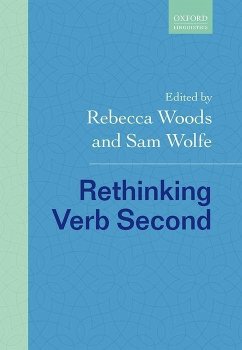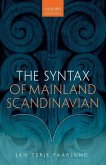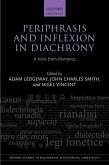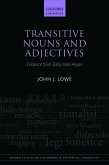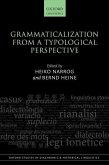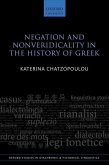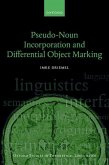Rethinking Verb Second
Herausgeber: Woods, Rebecca; Wolfe, Sam
Rethinking Verb Second
Herausgeber: Woods, Rebecca; Wolfe, Sam
- Gebundenes Buch
- Merkliste
- Auf die Merkliste
- Bewerten Bewerten
- Teilen
- Produkt teilen
- Produkterinnerung
- Produkterinnerung
This book offers the most exhaustive and comprehensive treatment available of the Verb Second property. It includes formal theoretical work alongside psycholinguistic and language acquisition studies, examines data from a range of languages, and shows that V2 phenomena are much more widely attested cross-linguistically than previously thought.
Andere Kunden interessierten sich auch für
![The Syntax of Mainland Scandinavian The Syntax of Mainland Scandinavian]() Jan Terje Faarlund ( Professor Emeritus of Scandinavian LinguisticsThe Syntax of Mainland Scandinavian149,99 €
Jan Terje Faarlund ( Professor Emeritus of Scandinavian LinguisticsThe Syntax of Mainland Scandinavian149,99 €![Periphrasis and Inflexion in Diachrony Periphrasis and Inflexion in Diachrony]() Periphrasis and Inflexion in Diachrony184,99 €
Periphrasis and Inflexion in Diachrony184,99 €![Transitive Nouns and Adjectives Transitive Nouns and Adjectives]() John J. Lowe (University of Oxford Postdoctoral Researcher)Transitive Nouns and Adjectives167,99 €
John J. Lowe (University of Oxford Postdoctoral Researcher)Transitive Nouns and Adjectives167,99 €![Grammaticalization from a Typological Perspective Grammaticalization from a Typological Perspective]() Grammaticalization from a Typological Perspective180,99 €
Grammaticalization from a Typological Perspective180,99 €![Negation and Nonveridicality in the History of Greek Negation and Nonveridicality in the History of Greek]() Katerina Chatzopoulou (Instructor in Lin Instructor in LinguisticsNegation and Nonveridicality in the History of Greek141,99 €
Katerina Chatzopoulou (Instructor in Lin Instructor in LinguisticsNegation and Nonveridicality in the History of Greek141,99 €![Pseudo-Noun Incorporation and Differential Object Marking Pseudo-Noun Incorporation and Differential Object Marking]() Imke Driemel (Postdoctoral Researcher, Postdoctoral Researcher, HumPseudo-Noun Incorporation and Differential Object Marking153,99 €
Imke Driemel (Postdoctoral Researcher, Postdoctoral Researcher, HumPseudo-Noun Incorporation and Differential Object Marking153,99 €![Indefinites Between Latin and Romance Indefinites Between Latin and Romance]() Chiara Gianollo (Senior Assistant Profe Senior Assistant ProfessorIndefinites Between Latin and Romance149,99 €
Chiara Gianollo (Senior Assistant Profe Senior Assistant ProfessorIndefinites Between Latin and Romance149,99 €-
-
-
This book offers the most exhaustive and comprehensive treatment available of the Verb Second property. It includes formal theoretical work alongside psycholinguistic and language acquisition studies, examines data from a range of languages, and shows that V2 phenomena are much more widely attested cross-linguistically than previously thought.
Hinweis: Dieser Artikel kann nur an eine deutsche Lieferadresse ausgeliefert werden.
Hinweis: Dieser Artikel kann nur an eine deutsche Lieferadresse ausgeliefert werden.
Produktdetails
- Produktdetails
- Verlag: Oxford University Press
- Seitenzahl: 980
- Erscheinungstermin: 18. Mai 2020
- Englisch
- Abmessung: 255mm x 183mm x 62mm
- Gewicht: 1836g
- ISBN-13: 9780198844303
- ISBN-10: 0198844301
- Artikelnr.: 57753643
- Herstellerkennzeichnung
- Libri GmbH
- Europaallee 1
- 36244 Bad Hersfeld
- gpsr@libri.de
- Verlag: Oxford University Press
- Seitenzahl: 980
- Erscheinungstermin: 18. Mai 2020
- Englisch
- Abmessung: 255mm x 183mm x 62mm
- Gewicht: 1836g
- ISBN-13: 9780198844303
- ISBN-10: 0198844301
- Artikelnr.: 57753643
- Herstellerkennzeichnung
- Libri GmbH
- Europaallee 1
- 36244 Bad Hersfeld
- gpsr@libri.de
Rebecca Woods is Lecturer in Language and Cognition at Newcastle University. During the editing of this volume she was Senior Lecturer in Language Acquisition at the University of Huddersfield, having received her PhD in Linguistics from the University of York in 2016 for her work on the syntax of speech acts, which focuses on embedded verb movement. Her research interests lie in the syntax-semantics interface, especially the syntax and semantics of questions, and first language acquisition, both monolingual and multilingual. Sam Wolfe is Associate Professor of French Linguistics at the University of Oxford and a Fellow of St Catherine's College. Prior to this he held teaching and research positions at the Universities of Cambridge, Manchester, and Oxford as well as a Visiting Professorship at the University of Padua. His recent publications include Verb Second in Medieval Romance (2018) and he has published on a range of topics within French and comparative Romance linguistics, historical syntax, and formal syntax.
* 1: Sam Wolfe and Rebecca Woods: Introduction
* Part I: Classic Case Studies
* 2: Markus Bader: Objects in the German prefield: A view from language
production
* 3: Anders Holmberg: On the Bottleneck Hypothesis of Verb Second in
Swedish
* 4: Ciro Greco and Liliane Haegeman: Frame setters and microvariation
of subject-initial Verb Second
* 5: Christine Meklenborg Salvesen: Adverbial resumptive particles and
Verb Second
* 6: Craig Sailor: Rethinking 'residual' Verb Second
* 7: Phil Branigan: Multiple Feature Inheritance and the phase
structure of the left periphery
* 8: Horst Lohnstein: The grammatical basis of Verb Second: The case of
German
* 9: Hans-Martin Gärtner and Thórhallur Eyþórsson: Varieties of
dependent Verb Second and verbal mood: A view from Icelandic
* 10: Ásgrímur Angantýsson: The distribution of embedded Verb Second
and Verb Third in modern Icelandic
* 11: Marit Julien: The assertion analysis of declarative Verb Second
* 12: Hans-Martin Gärtner and Jens Michaelis: Verb Second declaratives,
assertion, and disjunction revisited
* 13: Rebecca Woods: A different perspective on embedded Verb Second:
Unifying embedded root phenomena
* Part II: Diachrony
* 14: Cecilia Poletto: Null subjects in Old Italian
* 15: Sam Wolfe: Rethinking Medieval Romance Verb Second
* 16: Charlotte Galves: Relaxed Verb Second in Classical Portuguese
* 17: Eric Haeberli, Susan Pintzuk, and Ann Taylor: Object pronoun
fronting and the nature of Verb Second in early English
* 18: Marieke Meelen: Reconstructing the rise of Verb Second in Welsh
* 19: Mélanie Jouitteau: Verb Second and the Left Edge Filling Trigger
* 20: Krzysztof Migdalski: On a diachronic relation between the
richness of Tense, Force, and second position effects
* 21: eljko Bokovi¿: On the syntax and prosody of Verb Second and
Clitic Second
* 22: George Walkden and Hannah Booth: Reassessing the historical
evidence for general embedded Verb Second
* 23: Svetlana Petrova: Embedded Verb Second in the history of German
* Part III: Variation and Acquisition
* 24: Ermenegildo Bidese, Andrea Padovan, and Alessandra Tomaselli:
Rethinking Verb Second and Nominative case assignment: New insights
from a Germanic variety in Northern Italy
* 25: Jan Casalicchio and Federica Cognola: Parameterizing 'lexical
subject-finite verb' inversion across Verb Second languages: On the
role of Relativized Minimality at the vP edge
* 26: Coppe van Urk: Verb Second is syntactic: Verb Third structures in
Dinka
* 27: Alessandra Giorgi and Sona Haroutuynian: Verb Second and Verb
Third in Modern Eastern Armenian
* 28: Molly Diesing and Beatrice Santorini: The scope of embedded Verb
Second in modern Yiddish
* 29: Heike Wiese, Mehmet Tahir Öncü, Hans G. Müller, and Eva
Wittenberg: Verb Third in spoken German: A natural order of
information
* 30: Alexander Andrason: Verb Second in Wymysorys
* 31: Emily Manetta: Expanding the typology of Verb Second VPE: The
case of Kashmiri
* 32: Colleen Fitzgerald: Second and first position in Tohono O'odham
auxiliaries
* 33: Terje Lohndal, Marit Westergaard, and Øystein A. Vangsnes: Verb
Second in Norwegian: Variation and acquisition
* 34: Emanuela Sanfelici, Corinna Trabandt, and Petra Schulz: The role
of variation of verb placement in the input: Evidence from the
acquisition of Verb Second and Verb Final German relative clauses
* 35: Isaac Gould: The role of ambiguity in child errors: A comparison
with Dependency Length Minimization
* 36: Rebecca Woods and Tom Roeper: Rethinking auxiliary doubling in
adult and child language
* References
* Index
* Part I: Classic Case Studies
* 2: Markus Bader: Objects in the German prefield: A view from language
production
* 3: Anders Holmberg: On the Bottleneck Hypothesis of Verb Second in
Swedish
* 4: Ciro Greco and Liliane Haegeman: Frame setters and microvariation
of subject-initial Verb Second
* 5: Christine Meklenborg Salvesen: Adverbial resumptive particles and
Verb Second
* 6: Craig Sailor: Rethinking 'residual' Verb Second
* 7: Phil Branigan: Multiple Feature Inheritance and the phase
structure of the left periphery
* 8: Horst Lohnstein: The grammatical basis of Verb Second: The case of
German
* 9: Hans-Martin Gärtner and Thórhallur Eyþórsson: Varieties of
dependent Verb Second and verbal mood: A view from Icelandic
* 10: Ásgrímur Angantýsson: The distribution of embedded Verb Second
and Verb Third in modern Icelandic
* 11: Marit Julien: The assertion analysis of declarative Verb Second
* 12: Hans-Martin Gärtner and Jens Michaelis: Verb Second declaratives,
assertion, and disjunction revisited
* 13: Rebecca Woods: A different perspective on embedded Verb Second:
Unifying embedded root phenomena
* Part II: Diachrony
* 14: Cecilia Poletto: Null subjects in Old Italian
* 15: Sam Wolfe: Rethinking Medieval Romance Verb Second
* 16: Charlotte Galves: Relaxed Verb Second in Classical Portuguese
* 17: Eric Haeberli, Susan Pintzuk, and Ann Taylor: Object pronoun
fronting and the nature of Verb Second in early English
* 18: Marieke Meelen: Reconstructing the rise of Verb Second in Welsh
* 19: Mélanie Jouitteau: Verb Second and the Left Edge Filling Trigger
* 20: Krzysztof Migdalski: On a diachronic relation between the
richness of Tense, Force, and second position effects
* 21: eljko Bokovi¿: On the syntax and prosody of Verb Second and
Clitic Second
* 22: George Walkden and Hannah Booth: Reassessing the historical
evidence for general embedded Verb Second
* 23: Svetlana Petrova: Embedded Verb Second in the history of German
* Part III: Variation and Acquisition
* 24: Ermenegildo Bidese, Andrea Padovan, and Alessandra Tomaselli:
Rethinking Verb Second and Nominative case assignment: New insights
from a Germanic variety in Northern Italy
* 25: Jan Casalicchio and Federica Cognola: Parameterizing 'lexical
subject-finite verb' inversion across Verb Second languages: On the
role of Relativized Minimality at the vP edge
* 26: Coppe van Urk: Verb Second is syntactic: Verb Third structures in
Dinka
* 27: Alessandra Giorgi and Sona Haroutuynian: Verb Second and Verb
Third in Modern Eastern Armenian
* 28: Molly Diesing and Beatrice Santorini: The scope of embedded Verb
Second in modern Yiddish
* 29: Heike Wiese, Mehmet Tahir Öncü, Hans G. Müller, and Eva
Wittenberg: Verb Third in spoken German: A natural order of
information
* 30: Alexander Andrason: Verb Second in Wymysorys
* 31: Emily Manetta: Expanding the typology of Verb Second VPE: The
case of Kashmiri
* 32: Colleen Fitzgerald: Second and first position in Tohono O'odham
auxiliaries
* 33: Terje Lohndal, Marit Westergaard, and Øystein A. Vangsnes: Verb
Second in Norwegian: Variation and acquisition
* 34: Emanuela Sanfelici, Corinna Trabandt, and Petra Schulz: The role
of variation of verb placement in the input: Evidence from the
acquisition of Verb Second and Verb Final German relative clauses
* 35: Isaac Gould: The role of ambiguity in child errors: A comparison
with Dependency Length Minimization
* 36: Rebecca Woods and Tom Roeper: Rethinking auxiliary doubling in
adult and child language
* References
* Index
* 1: Sam Wolfe and Rebecca Woods: Introduction
* Part I: Classic Case Studies
* 2: Markus Bader: Objects in the German prefield: A view from language
production
* 3: Anders Holmberg: On the Bottleneck Hypothesis of Verb Second in
Swedish
* 4: Ciro Greco and Liliane Haegeman: Frame setters and microvariation
of subject-initial Verb Second
* 5: Christine Meklenborg Salvesen: Adverbial resumptive particles and
Verb Second
* 6: Craig Sailor: Rethinking 'residual' Verb Second
* 7: Phil Branigan: Multiple Feature Inheritance and the phase
structure of the left periphery
* 8: Horst Lohnstein: The grammatical basis of Verb Second: The case of
German
* 9: Hans-Martin Gärtner and Thórhallur Eyþórsson: Varieties of
dependent Verb Second and verbal mood: A view from Icelandic
* 10: Ásgrímur Angantýsson: The distribution of embedded Verb Second
and Verb Third in modern Icelandic
* 11: Marit Julien: The assertion analysis of declarative Verb Second
* 12: Hans-Martin Gärtner and Jens Michaelis: Verb Second declaratives,
assertion, and disjunction revisited
* 13: Rebecca Woods: A different perspective on embedded Verb Second:
Unifying embedded root phenomena
* Part II: Diachrony
* 14: Cecilia Poletto: Null subjects in Old Italian
* 15: Sam Wolfe: Rethinking Medieval Romance Verb Second
* 16: Charlotte Galves: Relaxed Verb Second in Classical Portuguese
* 17: Eric Haeberli, Susan Pintzuk, and Ann Taylor: Object pronoun
fronting and the nature of Verb Second in early English
* 18: Marieke Meelen: Reconstructing the rise of Verb Second in Welsh
* 19: Mélanie Jouitteau: Verb Second and the Left Edge Filling Trigger
* 20: Krzysztof Migdalski: On a diachronic relation between the
richness of Tense, Force, and second position effects
* 21: eljko Bokovi¿: On the syntax and prosody of Verb Second and
Clitic Second
* 22: George Walkden and Hannah Booth: Reassessing the historical
evidence for general embedded Verb Second
* 23: Svetlana Petrova: Embedded Verb Second in the history of German
* Part III: Variation and Acquisition
* 24: Ermenegildo Bidese, Andrea Padovan, and Alessandra Tomaselli:
Rethinking Verb Second and Nominative case assignment: New insights
from a Germanic variety in Northern Italy
* 25: Jan Casalicchio and Federica Cognola: Parameterizing 'lexical
subject-finite verb' inversion across Verb Second languages: On the
role of Relativized Minimality at the vP edge
* 26: Coppe van Urk: Verb Second is syntactic: Verb Third structures in
Dinka
* 27: Alessandra Giorgi and Sona Haroutuynian: Verb Second and Verb
Third in Modern Eastern Armenian
* 28: Molly Diesing and Beatrice Santorini: The scope of embedded Verb
Second in modern Yiddish
* 29: Heike Wiese, Mehmet Tahir Öncü, Hans G. Müller, and Eva
Wittenberg: Verb Third in spoken German: A natural order of
information
* 30: Alexander Andrason: Verb Second in Wymysorys
* 31: Emily Manetta: Expanding the typology of Verb Second VPE: The
case of Kashmiri
* 32: Colleen Fitzgerald: Second and first position in Tohono O'odham
auxiliaries
* 33: Terje Lohndal, Marit Westergaard, and Øystein A. Vangsnes: Verb
Second in Norwegian: Variation and acquisition
* 34: Emanuela Sanfelici, Corinna Trabandt, and Petra Schulz: The role
of variation of verb placement in the input: Evidence from the
acquisition of Verb Second and Verb Final German relative clauses
* 35: Isaac Gould: The role of ambiguity in child errors: A comparison
with Dependency Length Minimization
* 36: Rebecca Woods and Tom Roeper: Rethinking auxiliary doubling in
adult and child language
* References
* Index
* Part I: Classic Case Studies
* 2: Markus Bader: Objects in the German prefield: A view from language
production
* 3: Anders Holmberg: On the Bottleneck Hypothesis of Verb Second in
Swedish
* 4: Ciro Greco and Liliane Haegeman: Frame setters and microvariation
of subject-initial Verb Second
* 5: Christine Meklenborg Salvesen: Adverbial resumptive particles and
Verb Second
* 6: Craig Sailor: Rethinking 'residual' Verb Second
* 7: Phil Branigan: Multiple Feature Inheritance and the phase
structure of the left periphery
* 8: Horst Lohnstein: The grammatical basis of Verb Second: The case of
German
* 9: Hans-Martin Gärtner and Thórhallur Eyþórsson: Varieties of
dependent Verb Second and verbal mood: A view from Icelandic
* 10: Ásgrímur Angantýsson: The distribution of embedded Verb Second
and Verb Third in modern Icelandic
* 11: Marit Julien: The assertion analysis of declarative Verb Second
* 12: Hans-Martin Gärtner and Jens Michaelis: Verb Second declaratives,
assertion, and disjunction revisited
* 13: Rebecca Woods: A different perspective on embedded Verb Second:
Unifying embedded root phenomena
* Part II: Diachrony
* 14: Cecilia Poletto: Null subjects in Old Italian
* 15: Sam Wolfe: Rethinking Medieval Romance Verb Second
* 16: Charlotte Galves: Relaxed Verb Second in Classical Portuguese
* 17: Eric Haeberli, Susan Pintzuk, and Ann Taylor: Object pronoun
fronting and the nature of Verb Second in early English
* 18: Marieke Meelen: Reconstructing the rise of Verb Second in Welsh
* 19: Mélanie Jouitteau: Verb Second and the Left Edge Filling Trigger
* 20: Krzysztof Migdalski: On a diachronic relation between the
richness of Tense, Force, and second position effects
* 21: eljko Bokovi¿: On the syntax and prosody of Verb Second and
Clitic Second
* 22: George Walkden and Hannah Booth: Reassessing the historical
evidence for general embedded Verb Second
* 23: Svetlana Petrova: Embedded Verb Second in the history of German
* Part III: Variation and Acquisition
* 24: Ermenegildo Bidese, Andrea Padovan, and Alessandra Tomaselli:
Rethinking Verb Second and Nominative case assignment: New insights
from a Germanic variety in Northern Italy
* 25: Jan Casalicchio and Federica Cognola: Parameterizing 'lexical
subject-finite verb' inversion across Verb Second languages: On the
role of Relativized Minimality at the vP edge
* 26: Coppe van Urk: Verb Second is syntactic: Verb Third structures in
Dinka
* 27: Alessandra Giorgi and Sona Haroutuynian: Verb Second and Verb
Third in Modern Eastern Armenian
* 28: Molly Diesing and Beatrice Santorini: The scope of embedded Verb
Second in modern Yiddish
* 29: Heike Wiese, Mehmet Tahir Öncü, Hans G. Müller, and Eva
Wittenberg: Verb Third in spoken German: A natural order of
information
* 30: Alexander Andrason: Verb Second in Wymysorys
* 31: Emily Manetta: Expanding the typology of Verb Second VPE: The
case of Kashmiri
* 32: Colleen Fitzgerald: Second and first position in Tohono O'odham
auxiliaries
* 33: Terje Lohndal, Marit Westergaard, and Øystein A. Vangsnes: Verb
Second in Norwegian: Variation and acquisition
* 34: Emanuela Sanfelici, Corinna Trabandt, and Petra Schulz: The role
of variation of verb placement in the input: Evidence from the
acquisition of Verb Second and Verb Final German relative clauses
* 35: Isaac Gould: The role of ambiguity in child errors: A comparison
with Dependency Length Minimization
* 36: Rebecca Woods and Tom Roeper: Rethinking auxiliary doubling in
adult and child language
* References
* Index

